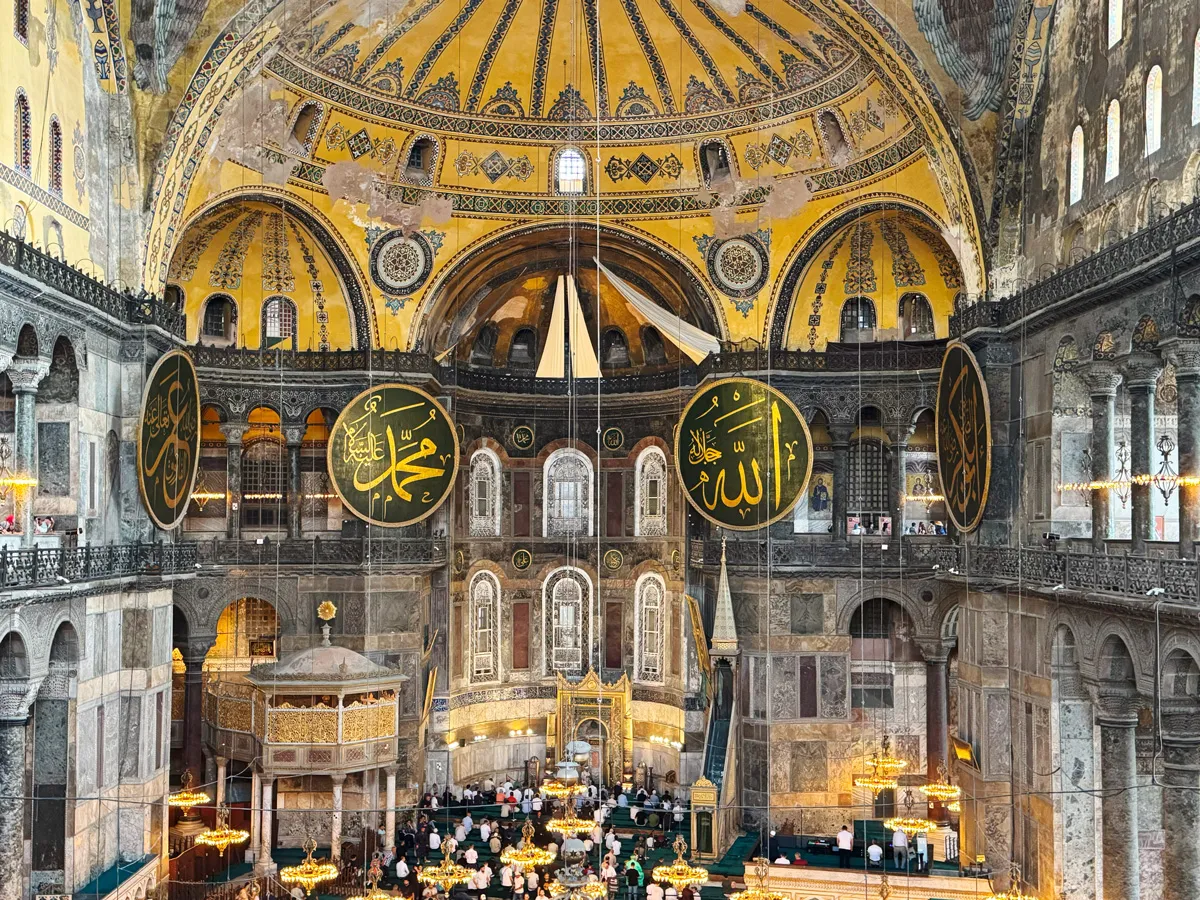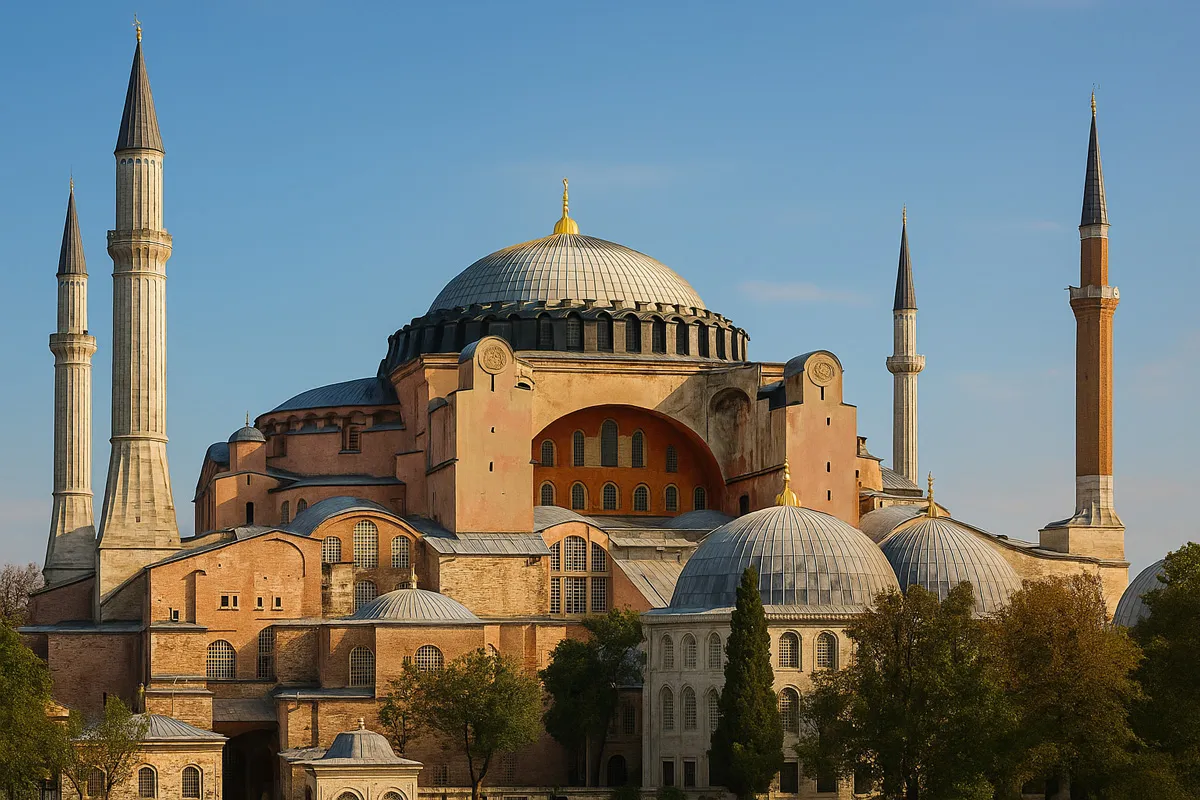Introduction | Discover the “Mosque Floating on the Sea”
Istanbul is famous for its many mosques. If you’ve already visited Hagia Sophia and the Blue Mosque, your next must-see destination is the Ortaköy Mosque (official name: Büyük Mecidiye Camii).
Standing gracefully on the Bosphorus shoreline, this mosque is often called the “Mosque Floating on the Sea”. It is admired for its stunning exterior and enchanting interior decoration.
In this guide, you’ll find everything you need: history, architecture, the best photo spots, access information, nearby hotels, and FAQs.
-1024x768.png)
Ortaköy Mosque (Büyük Mecidiye Camii) – Key Information
| Item | Details |
| Official Name | Büyük Mecidiye Camii |
| Location | Mecidiye, Mecidiye Camii Sk. No:1, Beşiktaş, Istanbul |
| Construction | Started in 1853, completed in 1855 (under Sultan Abdulmecid I) |
| Architects | Garabet & Nigoğayos Balyan (Armenian court architects) |
| Architectural Style | Neo-Baroque, with Rococo and Arabesque influences |
| Entrance Fee | Free (donations welcome) |
| Opening Hours | Daily (closed during prayer times) |
| Dress Code | Women: bring a scarf. Both men & women: modest, non-revealing clothing |
-1024x768.png)
Historical Background | A Symbol of the Tanzimat Era
Built during the Tanzimat reforms (1839–1876), a key period of modernization in the Ottoman Empire, Ortaköy Mosque represents a fusion of traditional Islamic architecture with Western Neo-Baroque design.
At that time, the Ortaköy district was a multicultural hub where Muslims, Jews, Greeks, and Armenians lived together. This cultural diversity influenced the mosque’s unique artistic and spiritual atmosphere.
-1024x768.png)
Architecture & Interior Design | Stunning Visuals and Sacred Meaning
Exterior Highlights
- White marble façade with detailed stone carvings
- Two slender minarets rising against the Bosphorus backdrop
- Popular panorama shots with the Bosphorus Bridge in the background
Interior | A Space of Light and Color
- Large stained-glass windows create a mystical play of light across the prayer hall
- Dome ceiling: pink and white marble with golden calligraphy, rising about 25 meters high
- A massive crystal chandelier imported from Europe in the 19th century
- Mihrab and minbar decorated with Baroque-style carvings
.png)
Dome & Ceiling Decoration
- Soft pink, white, and gold tones dominate the palette
- Golden Arabic calligraphy adorns the ceiling
- Trompe-l’œil style geometric motifs add a three-dimensional illusion of height
- The grand chandelier emphasizes the dome’s magnificence
-768x1024.png)
Mihrab | The Prayer Niche
The mihrab indicates the direction of Mecca (qibla) for Muslim prayer.
- Semi-circular or arched design on the main wall
- Decorated with marble and floral motifs
- At Ortaköy Mosque, crafted from pink marble with fine botanical and geometric reliefs
-768x1024.png)
Minbar | The Pulpit
The minbar is a pulpit with stairs, used by imams during Friday sermons (khutbah).
- Located beside the mihrab
- At Ortaköy Mosque, built with pink and white marble, enriched with Baroque details
- A beautiful blend of Islamic artistry and Western design elements
-1-1024x576.png)
Restoration History | The “Flower by the Water” Reborn
|
Year |
Event |
|
1894 |
Earthquake damaged dome and minarets |
|
1909 |
Major restoration; minaret tops redesigned |
|
1960s |
Dome reconstruction and foundation reinforcement |
|
1984 |
Fire damaged part of the interior; restoration followed |
|
2011–2014 |
Large-scale restoration; reopened June 6, 2014 |
Access | How to Get There
- Nearest Stations: Kabataş or Beşiktaş
- From Kabataş: ~15 minutes by bus
- From Old City: 15–20 minutes by taxi (traffic dependent)
- Walking along the Bosphorus promenade is also popular
- Ortaköy is a regular stop on Bosphorus cruises
Photo Spots & Best Times
|
Spot |
Highlights |
Best Time |
|
Pier Square (Ortaköy İskelesi) |
Mosque appears to float on the sea, with Bosphorus Bridge behind |
Morning or late afternoon |
|
Under the Chandelier |
Looking upward: symmetry of dome calligraphy & chandelier |
2–4 PM (best natural light) |
|
Mihrab & Minbar |
Pink marble & golden decorations |
Morning after prayer |
|
North Promenade (near cafés) |
Panoramic angle of mosque + sea + sky |
4–6 PM (silhouette shots) |
|
Sunset View |
“Magic hour” glow, mosque reflections on water |
30 min before to 15 min after sunset |
Photo Tips:
- Use a tripod early morning or late evening
- Wide-angle lenses (or smartphone 0.5x mode) recommended
- For fewer crowds, visit on weekdays before 9 AM
- Drone photography requires official permits
-1024x576.png)
Nearby Attractions & Hotels
- Seafront hotels with balconies are popular for couples
- Often included in GetYourGuide one-day Istanbul tours
- Perfect to combine with Bosphorus cruises
FAQ
- Is there an entrance fee?
-
No, admission is free (as of 2025). Donations are appreciated.
- Is there a dress code?
-
Yes. Women must wear a scarf, and both genders should avoid shorts or sleeveless tops.
- When is it least crowded?
-
Weekday mornings are quieter; late afternoon before sunset tends to be busy.
- Can I take photos inside?
-
Yes, but please avoid disturbing worshippers during prayer.
Related Articles
- [Top 7 Mosques in Istanbul Beyond the Blue Mosque]
- [Bosphorus Cruise Guide: Routes & Booking Tips]
- [Traveler’s Guide: Dress Code & Etiquette in Turkish Mosques]
Conclusion | Ortaköy Mosque Is a Must-Visit
History, art, spirituality, and scenic beauty—all in one place.
The Ortaköy Mosque is not only one of the most beautiful mosques in Istanbul but also one of the most memorable. Unlike heavily crowded sites, it allows a calmer and deeper cultural experience.
On your next trip to Istanbul, don’t miss this “Mosque Floating on the Sea”—a true architectural and cultural masterpiece.
-768x1024.png)




.png)
-400x300.png)